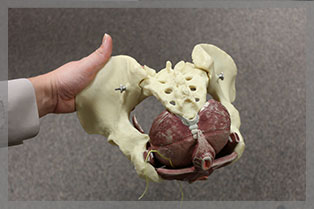 Some women suffer from a pain condition called vulvodynia. Pain is not only isolated to the opening of the vagina, as in vestibulodynia, but can be felt anywhere in the vulva, perineum and vagina. Pain is usually constant, but can be intermittent and triggered or worsened by contact such as intercourse or other sexual touch, tampon use, a medical exam, riding a bike, sitting, or wearing tight clothing. Considering that vulvodynia is often misdiagnosed, it is important that women are informed about this condition – the causes, treatment and supports – enabling women to make informed decisions regarding their health care.
Some women suffer from a pain condition called vulvodynia. Pain is not only isolated to the opening of the vagina, as in vestibulodynia, but can be felt anywhere in the vulva, perineum and vagina. Pain is usually constant, but can be intermittent and triggered or worsened by contact such as intercourse or other sexual touch, tampon use, a medical exam, riding a bike, sitting, or wearing tight clothing. Considering that vulvodynia is often misdiagnosed, it is important that women are informed about this condition – the causes, treatment and supports – enabling women to make informed decisions regarding their health care.
Although pain can be present with or without physical contact, it is often exacerbated by contact and can vary in intensity and frequency, from very occasional to constant and unrelenting. The type of discomfort can also vary, ranging from mild burning to knife-like pain. Many women experience increased pain at a specific point in their menstrual cycle. Approximately 40% of women also experience simultaneous bladder and bowel conditions and other pain conditions.
Often misdiagnosed as a yeast infection or psychological issue, the cause of this condition is unknown. Medical examinations and laboratory test results are negative for bacterial and fungal infections and skin conditions. The medical community believes that vulvodynia may be caused by injury or irritation of the pain nerves in response to trauma, infection, or sensitivity to environmental factors. Most women with vulvodynia have increased tension or spasm of the pelvic floor (the muscles that support the pelvic organs and surround the vaginal opening).
Several different treatment options are available. Physical therapy, medications, dietary modifications, stress and pain management, counselling and exercise are common treatment approaches.
Physical therapy treatment has many aspects, ranging from learning how to control both the contraction and relaxation of the muscles surrounding the vagina, desensitizing the painful areas to touch, the use of vaginal inserts and information regarding dietary modifications.
At Dayan Physiotherapy, we use biofeedback to help women learn how to relax these muscles (the pelvic floor), and if there is pain, what to do to minimize or eliminate the discomfort. In this way, anxiety can be eliminated as women take back control of their vaginas! Information regarding nonpainful sexual activity and the physiology of pain and of the male and female sexual response are also important treatment components. As several different treatment options can be helpful, we can help direct you to other healthcare professionals knowledgeable about this condition. If you already have other supports, we commit to working as part of your team.
Educate yourself. Women often find a holistic, multi-faceted approach to management of vulvar pain works best. Information, support and treatment options are available; the path is individual. At Dayan Physiotherapy, we help you learn about your options and make informed choices. Remember, the problem is in your vagina – not in your head!
